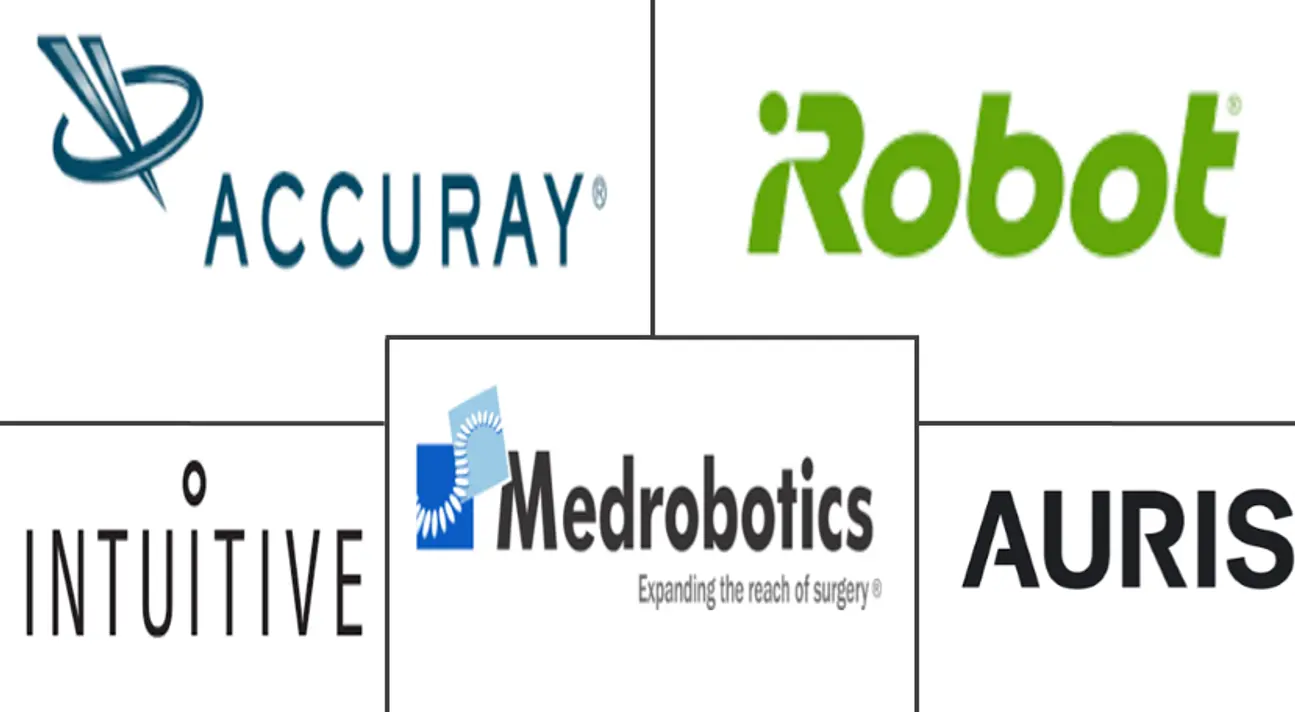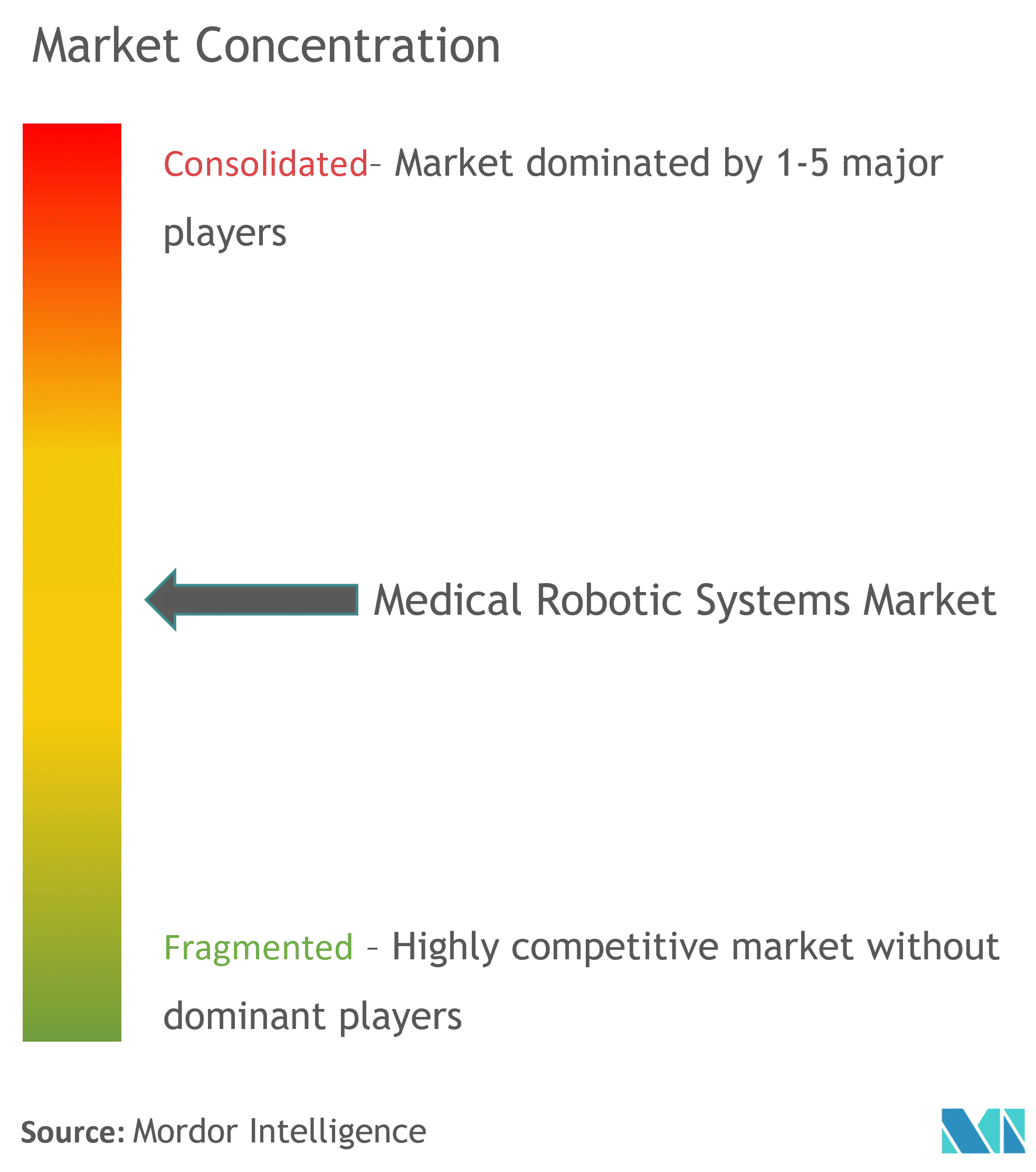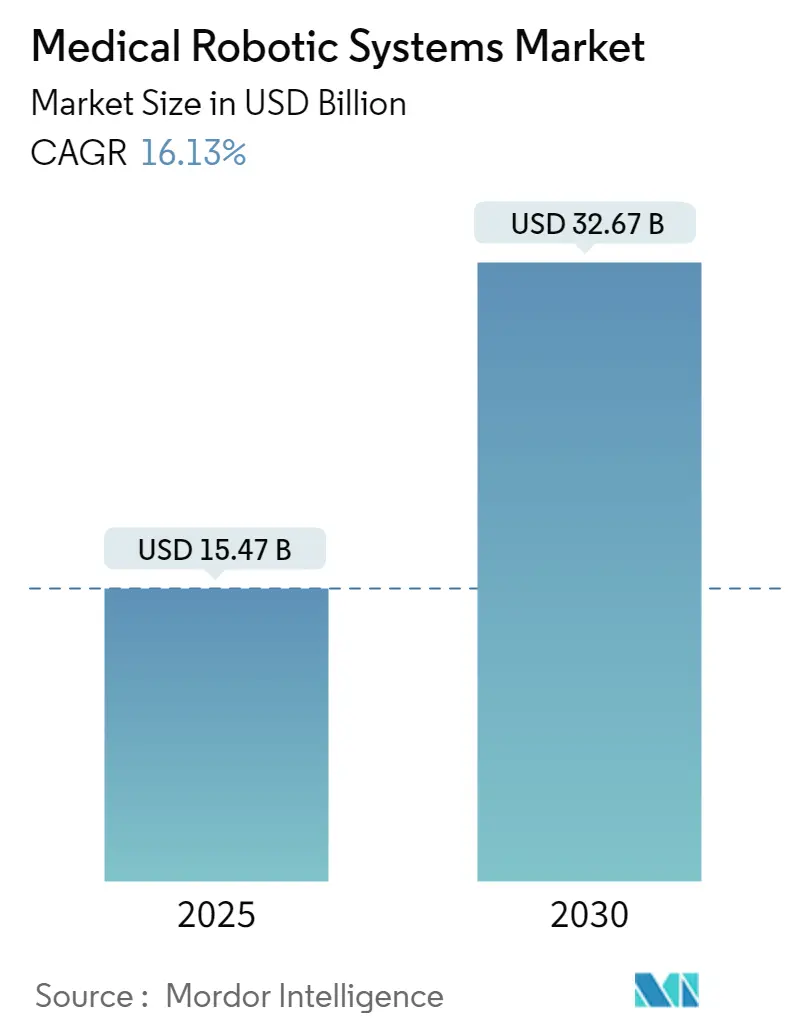
Medical Robotic Systems Market Analysis
The Medical Robotic Systems Market size is estimated at USD 15.47 billion in 2025, and is expected to reach USD 32.67 billion by 2030, at a CAGR of 16.13% during the forecast period (2025-2030).
The public's perception of medical robots in senior living facilities has improved over the last few years. One of the key initiatives that could lower the number of ER visits brought on by accidental falls and increase the accessibility and affordability of at-home care is the implementation of robotic care.
With the rising number of surgical procedures in the geriatric population and mounting cases of trauma injuries, the demand for accurate and proper laparoscopic surgeries and medical procedure solutions has been increasing. As a result, robot-assisted surgery has quickly expanded due to growing opportunities for minimally invasive surgery across the surgical domains. As robotic surgery approaches a decade of commercial use, the market is diversifying, and novel surgical modalities with the new technology decreased costs, and smaller sizes are becoming available.
For instance, medical robots have also increased for intervention and diagnostic purposes. Recent years have also witnessed the application area of robotics and automation solutions extending to medical/pharmaceutical research laboratories, where they are increasingly being used to automate manual, repetitive, and high-volume tasks so scientists and technicians can focus their attention on more strategic tasks to ensure discoveries happen faster.
For a significant period, intuitive surgical procedures have dominated the robotic surgical market and maintained a considerable market share. With original da Vinci patents expiring, the stage is set for an exponential increase in automatic system development. The newer systems seek to improve the da Vinci model through three main avenues: novel technology, reduced cost, and size reduction.
Furthermore, US and European hospitals have rapidly adopted robotic surgery to treat various conditions. One of the most widely used clinical robotic surgical systems includes mechanical and camera arms with surgical instruments attached. Examples of robot-assisted procedures include biopsies, removal of cancerous tumors, repairing heart valves, and gastric bypasses.
Despite all these benefits, factors such as a higher adoption cost, a lower awareness, especially in developing regions, and a lack of technical expertise to operate robotic medical systems are among the significant factor challenging the growth of the studied market.
Due to the significant risk that COVID-19 poses to surgeons, various surgical associations developed safety recommendations for these procedures in the present pandemic. Robots can be included in different parts of the sequence that each surgical patient travels through during their hospital stay to successfully prevent the spread of pathogens. As a result of the greater exposure the pandemic has provided and the benefits these systems offer, the adoption of robotic medical systems is anticipated to grow further during the forecast period.
Medical Robotic Systems Market Trends
Surgical Robots to Dominate the Market
Robotic surgery is a minimally invasive surgery utilizing robotics for performing surgical procedures. These robotic systems are operated by surgeons and consist of miniaturized surgical instruments mounted on robotic arms, thus allowing surgeons to perform the surgeries precisely.
The key factors boosting the surgical robots segment are the increasing need for healthcare automation and the trend toward advanced robotic surgeries. To address motion and tissue resistance, researchers are developing new strategies with the adoption of collaborative robots. For instance, Collaborative robots assist in lowering the possibility of human contamination in delicate operations and sterile settings.
The surgical robotics segment accounted for a significant portion of medical robotics, owing to the rising adoption of robotic surgical systems across Tier-1 hospitals, demand for highly efficient replaceable components, increase in the volume of robotic procedures performed worldwide, and growing demand for instruments & accessories due to their recurring need per procedure.
Another major factor driving the adoption of surgical robots is that robotic surgeries have effectively solved the drawbacks of conventional laparoscopic and thoracoscopic surgery, enabling the completion of intricate and advanced surgical procedures with higher precision and a minimally intrusive method. Growing investment in advanced medical devices also creates a favorable outlook for the growth of the studied market. For instance, according to Mediobanca, an investment banking company, the revenue of the medical device industry is anticipated to grow from EUR 376 billion (~USD 402 billion) in 2017 to EUR 521 billion (~USD 557 billion) by 2024.
Furthermore, there is projected to be a major increase in the market's demand for surgical robots. This can be attributed to the increasing use of surgical robots in a variety of surgical procedures, including bariatric surgery, heller myotomy, gastrectomy, hernia repair, cholecystectomy, transoral surgery, and pancreatectomy, as well as an increase in the volume of general surgery procedures performed globally.
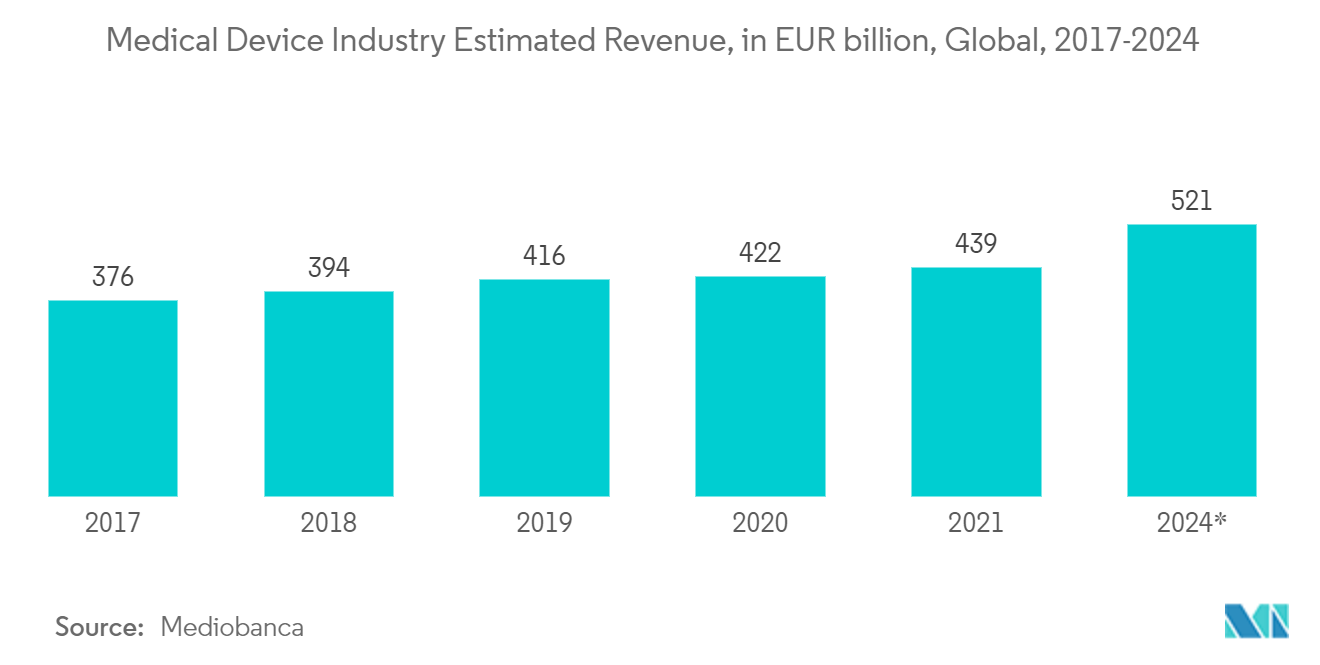
Asia Pacific to Witness the Highest Growth
The demand for the advanced and innovative healthcare infrastructure system in APAC will witness healthy growth during the forecast period. Medical robotics' market potential in the APAC area is expanding quickly. Governments across various countries are also looking for technological breakthroughs in their medical and pharmaceutical sectors, which are also critical to market expansion. This opens the door for greater accessibility to medical robotics, additional advancements, and larger investment in the upcoming years.
China contributes a majority of its market share in the region. Chinese demand for medical robots is mainly driven by the increasing adoption of instrument-based services. The demand is also supported by other factors, such as the lack of skilled physiotherapists and caretakers.
According to the South China Morning, while the da Vinci system is broadly used in China in more than 60,000 operations to date, the Chinese government is eager to reduce its dependence on foreign technology; as a result, it has backed more than 30 MedTech manufacturers who develop intelligent robots and robotic medical devices, including surgical robots in the past few years.
Such trends are also encouraging medical device manufacturers further enhance their R&D efforts to develop innovative solutions. For instance, in September 2022, a Shanghai-based robotics enterprise developed a four-arm laparoscopic surgical robot to help doctors carry out complex surgeries in narrow spaces.
Furthermore, in the ZhongkaiHi-Tech zone in Huizhou, SS Innovations is developing and testing an affordable, modular robotic surgical system capable of complex motion control. The company is working with a budget of around USD 15 million from the Chinese government to recruit and train talent worldwide.
Because Australia has been using robotic-assisted minimal access surgery (MAS) for approximately 20 years, the Australian medical robotics sector is well-sophisticated. Versius, a surgical robot designed to reduce the heavy physical demand on surgeons using conventional surgical robots, was recently introduced in Australia, demonstrating and securing the nation's position in the worldwide medical robotics industry.
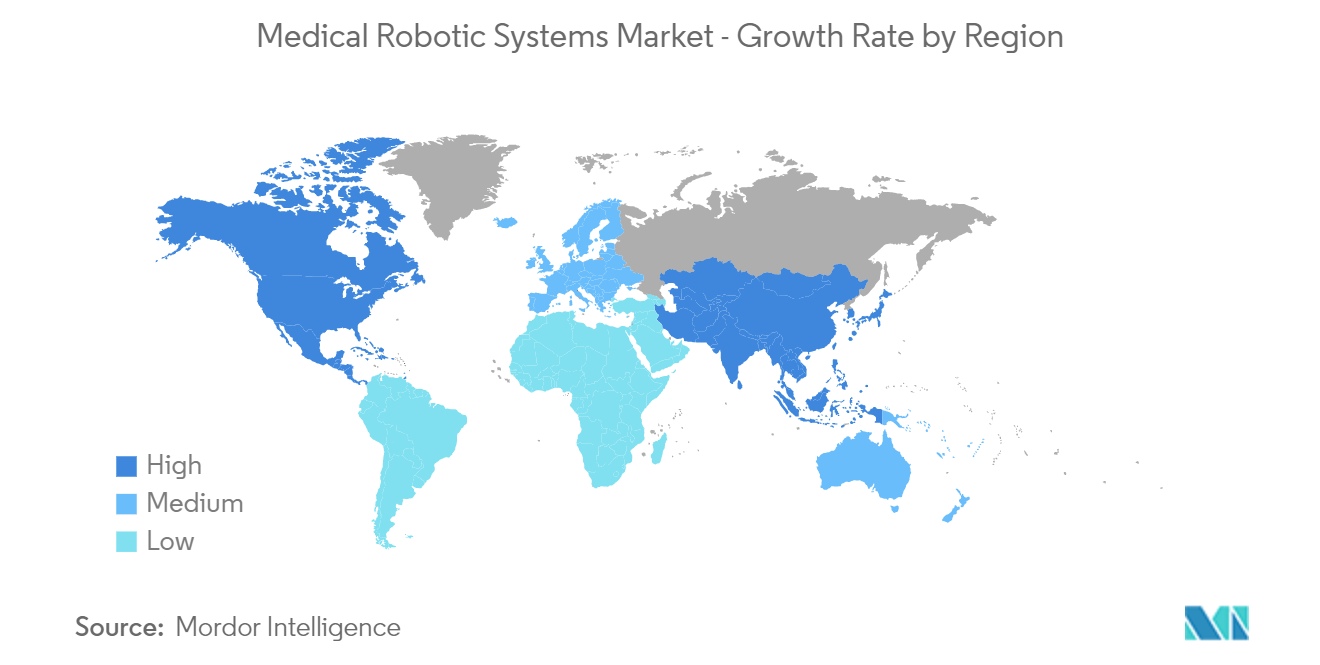
Medical Robotic Systems Industry Overview
The Medical Robotic Systems Market is competitive as the majority of the market demand is satisfied by the advanced offerings from major players despite the presence of several players. The growth and competitiveness can be attributed to Western partnerships to improve healthcare, the developing of surgical robots by domestic manufacturers, and multiple government collaborations with regional universities for research and development purposes. These companies are adopting strategic collaborative initiatives to increase their market share and profitability. Some key market players include Intuitive Surgical Inc., Auris Surgical Rbots Inc., and iRobot Corporation.
In April 2023, Apollo Cancer Centres, Navi Mumbai, launched the fourth-generation advanced Da Vinci Xi Robotic System that can be used in the field of oncology, urology, colorectal surgeries, gynecology, thoracic, cardiology, pediatric and gastrointestinal surgeries, kidney transplants and in liver transplantation.
In February 2023, Global Hospital, a Mumbai-based hospital, launched Da Vinci Xi Robotic Surgical System. This robotic surgical system is designed to allow surgeons to perform minimally invasive surgeries precisely and safely. According to the company, this advanced system will be used in various surgical fields, including gynecology, urology, oncology, liver transplantation, cardiology, thoracic, pediatric, and gastrointestinal surgery, to improve patient outcomes and quality of life.
Medical Robotic Systems Market Leaders
-
Intuitive Surgical Inc.
-
Auris Surgical Robotics, Inc. (Hansen Medical Inc.)
-
Accuray Incorporated
-
iRobot Corporation
-
Medrobotics Corporation
- *Disclaimer: Major Players sorted in no particular order
Medical Robotic Systems Market News
- Jan 2024: EndoQuest Robotics and Omnivision are collaborating to integrate advanced image sensor technology into surgical robotics. Omnivision will embed its OCHFA CameraCubeChip image sensor into EndoQuest's adaptable robotic system. The robot is currently under development and is yet to receive clearance from the US Food and Drug Administration (FDA). However, it has been accepted into the FDA's Safer Technologies Program (STeP).
- June 2023: Touchlab, a deep tech robotics company, introduced a first-of-its-kind robot that allows doctors to remotely 'feel' patients during a trial at a hospital in Finland. It is controlled by operators wearing special gloves; the Välkky telerobot uses advanced electronic skin technology to transfer the sense of touch from its robotic hand to users. Over a 3-month trial at Laakso Hospital in Helsinki, a trained nurse team will test how these robots can assist patient care, lessen their workload, and lower the risk of spreading infections or diseases.
- September 2022: Titan Medical agreed with Medtronic for a limited development program. In this, Medtronic will evaluate the performance of Titan's cameras and instruments in gynecological procedures, which the company plans to pursue as the first application for its surgical robot.
- June 2022: Intuitive, a global technology company and a pioneer of robotic-assisted surgery in minimally invasive care and the, announced the U.S. Food and Drug Administration had cleared the integration of a mobile cone-beam CT (CBCT) imaging technology and the Ion Endoluminal System used for robotic-assisted bronchoscopy.
- January 2022: Medrobotics Corp., a medical robotics company, announced that it received FDA regulatory clearance to market the Flex Robotic System for robot-assisted visualization in general surgical, gynecological, and thoracic procedures in the United States. This clearance reaffirms the company's progress in developing transformative products for single-port general, gynecological, thoracic, and urological surgeries.
Medical Robotic Systems Industry Segmentation
Medical robotic systems are fully or partially autonomous robots designed to assist medical personnel and facilities with surgeries, and hospital logistics, enhance patient care, and streamline clinical workflow and workplace safety.
The Medical Robotic Systems Market is segmented by Product Type (Surgical Robotic Systems, Rehabilitative Robotic Systems, Non-invasive Radiosurgery Robots, Hospital, and Pharmacy Robotic Systems) and Geography. The report offers the market size in value terms in USD for all the abovementioned segments.
| By Product Type | Surgical Robotic Systems | ||
| Rehabilitative Robotic Systems | |||
| Non-invasive Radiosurgery Robots | |||
| Hospital and Pharmacy Robotic Systems | |||
| Other Robotic Systems | |||
| By Geography | North America | United States | |
| Canada | |||
| Europe | Germany | ||
| United Kingdom | |||
| France | |||
| Rest of Europe | |||
| Asia Pacific | China | ||
| Japan | |||
| India | |||
| South Korea | |||
| Rest of Asia Pacific | |||
| Rest of the World | Latin America | ||
| Middle East and Africa | |||
Medical Robotics Systems Market Research FAQs
How big is the Medical Robotic Systems Market?
The Medical Robotic Systems Market size is expected to reach USD 15.47 billion in 2025 and grow at a CAGR of 16.13% to reach USD 32.67 billion by 2030.
What is the current Medical Robotic Systems Market size?
In 2025, the Medical Robotic Systems Market size is expected to reach USD 15.47 billion.
Who are the key players in Medical Robotic Systems Market?
Intuitive Surgical Inc., Auris Surgical Robotics, Inc. (Hansen Medical Inc.), Accuray Incorporated, iRobot Corporation and Medrobotics Corporation are the major companies operating in the Medical Robotic Systems Market.
Which is the fastest growing region in Medical Robotic Systems Market?
Asia Pacific is estimated to grow at the highest CAGR over the forecast period (2025-2030).
Which region has the biggest share in Medical Robotic Systems Market?
In 2025, the North America accounts for the largest market share in Medical Robotic Systems Market.
What years does this Medical Robotic Systems Market cover, and what was the market size in 2024?
In 2024, the Medical Robotic Systems Market size was estimated at USD 12.97 billion. The report covers the Medical Robotic Systems Market historical market size for years: 2019, 2020, 2021, 2022, 2023 and 2024. The report also forecasts the Medical Robotic Systems Market size for years: 2025, 2026, 2027, 2028, 2029 and 2030.
Our Best Selling Reports
Healthcare Robot Industry Report
Statistics for the 2025 Medical Robotic Systems market share, size and revenue growth rate, created by Mordor Intelligence™ Industry Reports. Medical Robotic Systems analysis includes a market forecast outlook for 2025 to 2030 and historical overview. Get a sample of this industry analysis as a free report PDF download.

